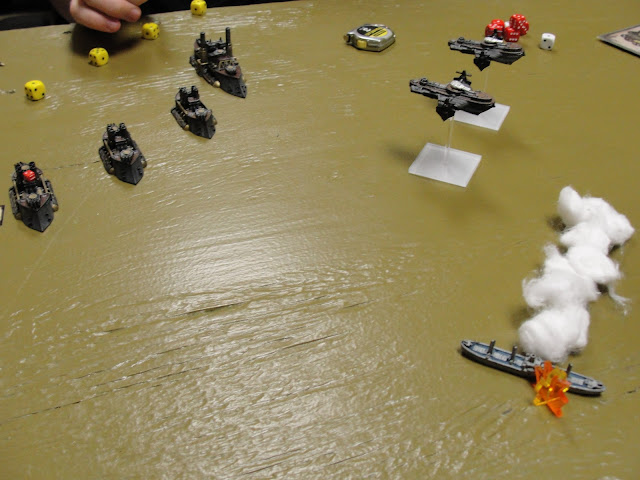Dawn breaks over the Sinai, and the British garrison wakes to find an American Armored regiment move to the crest of some dunes to the west of the Suez Canal. An American fleet approaches from the south, heavy warships escorting a convoy of transport ships. Farther to the south the KoB Suez Fleet makes full steam to intercept the American fleet. The American Commodore demands passage through the canal, but the British garrison is under strict orders to block passage, resorting to gunfire if necessary to force the FSA fleet to circle back and around the Horn of Africa.
Each player started with 900 points. Two 4x6 foot tables were used together to create the 4x9 playing space for the scenario. We had 15 square feet of desert for the land forces to fight over and more than 20 square feet of pea green Suez Gulf waters for the naval squadrons to engage.
The fleets were similarly matched with cruisers, some medium flyers (scout rotors for KoB and airships for FSA), and a matched set of battleship and dreadnought. The Land forces differed a bit more.Within the Gulf were 5 medium class merchant ships which were subject to random movement and effectively blocked LoS like terrain. The FSA player deployed his fleet and convoy before the start, but the KoB, pushing to catch up, had to deploy by activation, entering the sea zone between the yellow dice pictured in the lower port side corner. The KoB sent in the Scout Rotors ahead to survey the FSA fleet and determine what cargo those transports were carrying.
The land forces were set up on opposing corners from their respective naval counterparts. The KoB colonel controlled a coastal defense fortress at the southern entrance to the canal and deployed several bombards in a conservative position around the small, unnamed town. Approaches to the main bridge over the canal was heavily mined, and the gate (which could be crossed by small tanks) was left open. A pair of scout rotors dropped mines is the mouth of the canal. The FSA armored regiment to the west included more standard medium and small tanks, and just off the coast a pair of cruisers served as gunboats to neutralize the KoB scout rotors and shell the coastal fortress. The KoB team won initiative and despite warnings that the first side to open fire would likely start an international incident and suffer a penalty to victory points when scoring at the end, the British colonel ordered the bombards to open fire on the American armor at maximum range. No damage was inflicted.
The British commodore followed form by opening fire on a merchant vessel, sending up a thick cloud of burning oil which did obscure the scout rotors from American artillery fire. Neutral French observers were not pleased. The Americans returned fire.
In fact, the American colonel decided to capitalize on the favorable wind direction and fire on the helpless village which burned as well as the merchant ship. The special scenario rule here was that if a merchant ship or village was fired upon and took at least 2 hits then smoke would obscure all LoS for 6" downwind of the ship or village. By the end of turn one we had a merchant ship slowly sinking in the Gulf and a village burning in the north, but otherwise the military units hadn't scratched any paint and were preparing to escalate the conflict.
The forces began to clash on the second turn. The pair of American cruisers and British scout rotors came to boarding actions at the mouth of the canal.
And then the FSA dreadnought opened fire from extreme range. The coastal fortress, already damaged by bombardment from the armored regiment, didn't have enough AA to shoot down the salvo of rockets, and the FSA commodore rolled a lot of sixes.
In a strange twist of fortune and physics, the critical hit caused a sturginium flare, and the coastal fortress vanished from within a purple dome of light.
I was called away at the end of the second turn, but the conflagration continued. I was told that the American commodore continued to roll very well and the KoB fleet was torn apart and unable to stop the convoy from moving toward the canal.









